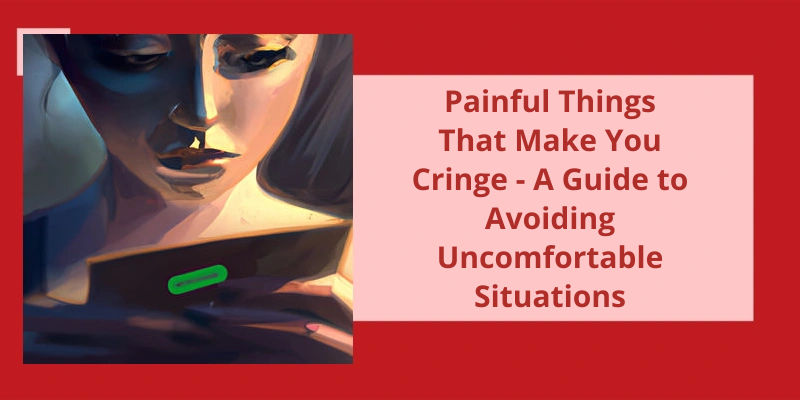We all know that feeling, that visceral reaction to something so cringe-worthy that it makes your skin crawl and your stomach churn. From nails on a chalkboard to seeing someone get their fingers caught in a door, there are certain things that just make us wince with discomfort. These painful experiences can range from physical sensations to emotional ones, and they can be triggered by a variety of situations. Whether it's watching a gruesome accident or hearing an embarrassing story, there are certain things that we can't help but react to in a way that's uncomfortable and downright unpleasant. In this article, we'll explore some of the most cringe-inducing things that can leave us feeling uneasy and ill-at-ease. So sit back, brace yourself, and get ready to experience some of the most painful things that make us cringe.
What Things Are Considered Cringe?
Cringiness is a characteristic that’s various interpretations depending on ones cultural and social background. Nonetheless, some things are universally agreed upon as awkward or uncomfortable to witness. One of them is when men address women with pet names such as “sweetie” or “honey.”. Such comments can be patronizing and insulting, and theres a general consensus that they aren’t an acceptable way of showing affection towards someone.
Another common source of cringe-worthy moments is poor grammar. Whether it’s a simple typographical error or a blatant misuse of the language, bad grammar can make people wince and roll their eyes. It creates a sense of discomfort for the listener and often, unwittingly signals a lack of intelligence or education on the speakers part.
Another thing that makes me cringe is a poor sense of fashion. Everyone has their own sense of style, but there are some fashion trends that are universally recognized as cringe-worthy. Examples include socks and sandals, excessively baggy clothing, and overly revealing clothing. Such fashion choices not only make the wearer look out of place, but they also make the people around them feel uncomfortable.
Along the same lines, another thing that can make me cringe is when guys try too hard to impress women. This includes using pickup lines that are cheesy or corny or attempting to brag about their accomplishments. These tactics might work in some cases, but more often than not, they’re seen as desperate and off-putting.
Another thing that makes me cringe is when people talk about love at first sight. While it’s certainly possible to feel an intense attraction towards someone the first time you meet them, the idea of immediately falling in love seems unrealistic and naive. Many people believe that true love takes time to develop, and talking about it as an instantaneous occurrence can seem disingenuous and cringe-worthy.
Finally, another common source of cringe is when people obsess over Disney. While theres nothing wrong with enjoying Disney movies or visiting Disney theme parks, some people take their love of Disney to an extreme level. They might decorate their homes with Disney memorabilia or dress up like their favorite Disney characters. While it’s all well and good to have a passion for something, obsession of any kind can be off-putting to others.
The feeling of cringing is something that’s universally experienced, but the reasons behind it vary from person to person. It can be triggered by a multitude of factors, both internal and external, and often involves feeling embarrassed or disgusted. Whether it stems from past experiences or discomfort with certain topics, the sensation of cringing is something that we all have to deal with at some point in our lives.
What Makes People Cringe?
Cringing is a natural human response to certain stimuli that make us feel uncomfortable, embarrassed, or anxious. There are several factors that can prompt the cringe, such as witnessing someone elses embarrassing or inappropriate behavior, hearing something offensive or disgusting, or recalling a past experience that was shameful.
This can be anything from a coworker telling a bad joke in a meeting to a friend getting too drunk at a party. In these situations, we may feel embarrassed for the person and uncomfortable as we try to distance ourselves from their behavior. This often results in a physical reaction, such as cringing, wincing, or looking away.
Another trigger for the cringe is hearing something offensive or disgusting. This can be anything from a racist comment to a graphic description of an injury. This can also result in a physical reaction, such as covering our ears or turning away.
The Psychology Behind Cringing: What Happens to Our Brain and Body When We Cringe?
This article explores the physiological and psychological processes that occur when we cringe. It examines the brain and body’s response to embarrassment, discomfort, and social awkwardness, and how these experiences trigger automatic bodily responses such as sweating, increased heart rate, and muscle tension. The article aims to shed light on the cringe-inducing moments we all experience and to help us better understand our reactions to them.
While cringe attacks are often associated with social situations, they can also be triggered by a variety of other experiences, such as watching a cringe-worthy moment on television or recalling a personal failure. Despite their uncomfortable nature, cringe attacks are a common occurrence and can be managed with coping mechanisms.
What Are Cringe Attacks?
Cringe attacks often happen when we’re reminded of something that we did in the past that we aren’t proud of. It could be a moment of social awkwardness, a mistake at work, or even just a bad decision that we made. These memories can be triggered by a variety of stimuli, such as a smell, a song, or a particular location. When we experience a cringe attack, we may feel physical symptoms like sweating, nausea, or a rapid heart rate.
One reason why cringe attacks can be so uncomfortable is that they tap into our deepest insecurities and vulnerabilities. When we feel embarrassed or ashamed, it can trigger feelings of worthlessness and self-doubt. We may worry that others will judge us or reject us if they find out about our past mistakes. This can lead to a vicious cycle of avoidance and isolation, where we withdraw from social situations and avoid taking risks.
Strategies for Coping With Cringe Attacks
This article outlines strategies to overcome feelings of embarrassment or discomfort, also known as cringe attacks. It provides practical tips and techniques that can help individuals manage their response to cringe-inducing situations. The strategies include techniques such as deep breathing, mindfulness, positive self-talk, and visualization, as well as seeking support from others and reframing negative thoughts. By using these strategies, individuals can better cope with cringe attacks and continue to engage in activities that may trigger such responses.
However, cringe-worthy moments tend to evoke a general feeling of discomfort or embarrassment in most people. It could be a result of poor execution, awkwardness, or violation of social norms. In this article, we will explore the subjective nature of cringe and how it’s been portrayed in different forms of media.
Is Cringe Subjective?
Some people may find certain situations or actions to be cringeworthy, while others may not have the same reaction. This can be due to factors such as personal experiences, cultural differences, and individual senses of humor. Additionally, what may be considered cringe-worthy in one context may be completely acceptable or even celebrated in another.
Furthermore, the concept of cringe can also be influenced by age. What younger generations may consider to be cool or trendy, older generations may view as cringey or ridiculous. This is often seen in pop culture, where newer styles or trends may be met with skepticism or disapproval from older generations.
Overall, the subjectivity of cringe highlights the importance of respecting individual perspectives and differences. While it may be easy to dismiss something as cringey, it’s important to recognize that our reactions to certain situations are informed by our personal experiences and beliefs.
The Evolution of Cringe: Have Our Definitions of What Is Cringe-Worthy Shifted Over Time, and if So, Why?
- The concept of cringe didn’t exist in ancient times. People were more concerned about survival and didn’t have the luxury to feel embarrassed or awkward.
- In the Middle Ages, etiquette and propriety became more important, and people started to have more social norms and expectations. This led to more opportunities for cringe-worthy moments, especially among the lower classes who weren’t as well-educated in social graces.
- During the Renaissance, there was a greater appreciation for individualism and self-expression. This led to more opportunities for creative expression, but also more opportunities for cringe moments as people experimented with new forms of art, music, and fashion.
- In the 20th century, with the rise of mass media and the internet, cringe became more of a phenomenon. With more people sharing their thoughts and experiences online, there are inevitably more opportunities for awkward moments and embarrassing mistakes to go viral.
- Today, there seems to be a greater awareness of cringe culture, and some people even seek out cringe-worthy content for entertainment. This may be due to a desire to connect with others who’ve similar experiences, or a fascination with the uncomfortable and awkward.
What Is an Example of Something Cringe?
, I witnessed something that made me cringe so hard that I’d to leave the room. It was during a meeting when one of my colleagues attempted to share a joke that fell completely flat. Nobody laughed, and the silence was so awkward that I physically cringed. It was one of those moments where you wish that the ground would swallow you up.
Another example of something cringe is when people overshare personal information. This can be in real life or on social media. It’s uncomfortable when someone talks about their health problems or personal issues in a public setting. Similarly, when someone shares too much information about their relationship or sex life, it can make others cringe. It’s important to have boundaries and be aware of what’s appropriate to share in different settings.
A cringe-worthy moment can also occur when someone tries too hard to be cool or impressive. We”ve all seen someone trying to show off, whether it’s by name-dropping or bragging about their possessions. It’s uncomfortable to witness, and it often has the opposite effect than what was intended. It’s important to be genuine and authentic rather than trying to impress others.
Another example of something cringe is when people use outdated or inappropriate language. This can include racist, sexist, or homophobic remarks. It’s important to be mindful of the impact that our words have on others, and to avoid hurtful language. Similarly, using incorrect grammar or mispronouncing words can make others cringe. It’s important to take the time to learn and use proper language, especially in professional settings.
There are many things that can make us cringe, from bad jokes to oversharing to inappropriate language. It’s important to be aware of our actions and words and how they impact others. By being authentic, respectful, and mindful, we can avoid cringe-worthy moments and build positive relationships with those around us.
Conclusion
In conclusion, any discussion of painful things that make one cringe is inherently difficult. It’s a topic that’s fraught with emotional weight and complicated by subjective experiences. However, by facing these uncomfortable moments head-on, we’ve the opportunity to learn about ourselves and build a greater sense of empathy and understanding for those around us. Though they may be hard to bear, the moments that make us cringe can be incredibly valuable in shaping who we’re and how we relate to the world. So while they may not be easy to confront, we should approach them with open hearts and minds, ready to grow and evolve as individuals.






